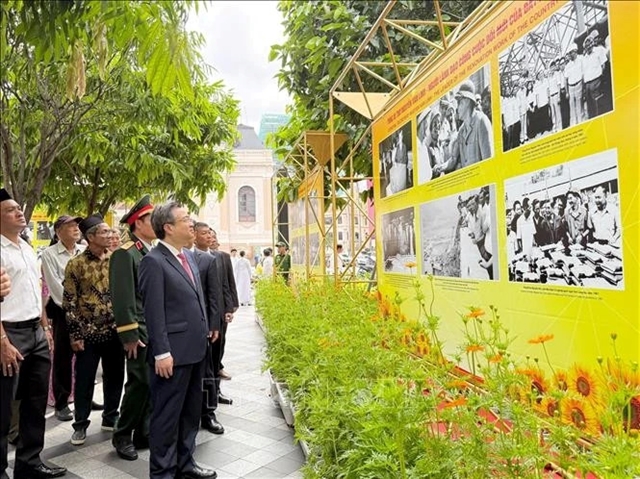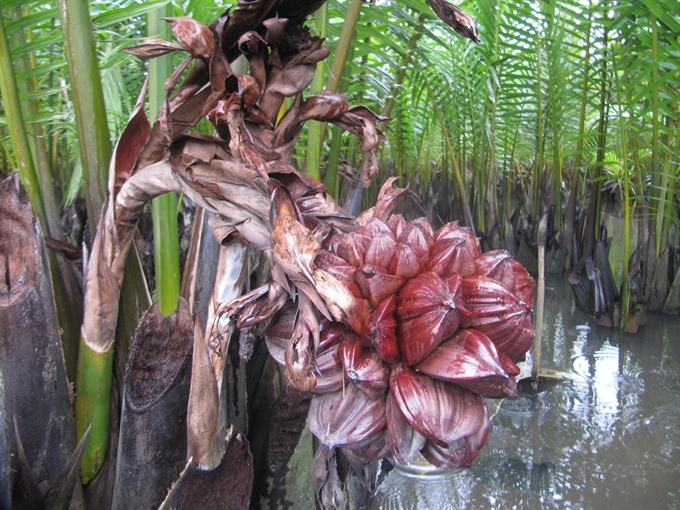

Nipa palms were very useful during the American War. They were planted in Cẩm Thanh Commune long ago after having been brought there from the south of Viet Nam.
 |
| Fruits of Nipa palm get aging in a short time. The fruit often drops to water and a sapling will grow again. VNS Photo Công Thành |
Nipa palms were very useful during the American War.
People could hide in forests that were full of these palm trees and feel safe.
Powerful ammunition fired from big guns could not even make it through these trees.
They were planted in Cẩm Thanh Commune long ago after having been brought there from the south of Viet Nam.
By Công Thành
Võ Tấn Mười, 74, has been living and preserving vast forests of nipa palms since they were grown by his great-great-grand father in the past three centuries.
An area of forest spanning 140ha, which was planted in the 18th century, has been a safe shelter for generations of Cẩm Thanh villagers through wars and natural disasters like storms and floods.
Prolonged flooding hit and damaged the central region through November 2016, but Cẩm Thanh Commune remained safe as larger waves and flood waters were blocked by the dense nipa palm forests.
Over 2,000 residents of Cẩm Thanh benefit from the wetland forest, making a living from eco-tour services and crafts.
Mười, who was a teenage courier and then a guerilla during the war, said his life had never been far away from the nipa palms.
“The nipa palm forest worked as a powerful ‘bunker’, when troops took advantage of the forest to avoid shelling and raids during the American war. Shrapnel couldn’t penetrate the thick palm trees, and we were mostly protected during the fierce war of the 1960s,” Mười recalled.
“The forest was a treasure for my ancestors 300 years ago. My great-great-grand father took the first sapling from wetland forests in the south of Việt Nam during a boat trading trip in the 18th century. The plant gradually took root in the new land, and it became a powerful green belt for the commune during annual disasters,” Mười said.
He said the primary forest was developed on an area of seven mẫu (Bảy Mẫu or seven hectares of swamps), and thus the initial name of the forest was born.
He said the name reminded local residents of the first hectares of forest planted centuries ago, but it has become a popular eco-tour site – the Nipa Palm forest of Cẩm Thanh in the area of Hội An.
The old man, known as a guard of the forest for almost all his life in the commune, said local craftsmen could earn a work day of a million Vietnamese đồng for their house decorations made from nipa palm material.
Mười said villagers used nipa palm leaves as a primary material for their own cottages or firewood in Cẩm Thanh commune, and now as a traditional pattern in modern design and architecture.
Development threat
Nipa palm expert Chu Mạnh Trinh, a team leader of the Chàm Islands Protected Marine Area, said poor planning and development had resulted in the destruction of half of the nipa palm forest area between 1975 and the late 1990s.
“A salt field in the late 1970s and an aquaculture farm development in the late 1990s had claimed 40ha of nipa palm area, while rapid urban expansion encroached on a further 20 per cent of the forest,” Trinh said.
“The situation was halted in 2014 when a series of research and warnings on the important role of the forest were given by experts and international organisations. The forest played a role as a safe shelter not only for local residents and fishing boats, but it was a source of fish and seafood in offshore Chàm Island,” Trinh explained.
“A number of scientific studies and dialogues proved that nipa palm is the most powerful plant in the wetlands of Cẩm Thanh and the ecological system ranging from Hội An to Cửa Đại estuary and Chàm Island,” he said, adding that nipa palm had a long existence of hundreds of years.
Trinh said a reforestation project, introduced by the Ministry of Agriculture and Rural Development, had replanted 30ha of nipa palm in Cửa Đại estuary.
Being careful
Trần Rô, a resident of Cẩm Thanh Village, said the forest had protected the commune from erosion and big waves during storm season.
“We recognised the importance of the nipa palm forest when we were educated on the ecosystem. We suffered from poor fishery when the forest was seriously damaged in the past, and we couldn’t explain why,” Rô said.
Teams of coracle paddlers, craftsmen, cooks and tour guides all serve eco-tours in the forest, but they take every chance to communicate the importance of environmental conservation.
“Any illegal actions of harvesting nipa palm and over-fishing in breeding season are met with warnings by community teams in combination with local administration,” he said.
Expert Chu Mạnh Trinh said constant dialogues and scientific conferences had been held in Hội An for years, raising awareness of the nipa palm among the community and leadership of Hội An City.
“The most important issue is that local residents are aware of the role of the nipa palm and their livelihood is connected with the growth of this wetland plant. We are thinking of creating more jobs for the local community in limiting human impacts on the existence of nipa palm,” Trinh said.
He said many international organisations including the International Union of Conservation of Nature (IUCN), the Mangrove for the Future (MFF), UNESCO, ministries and universities had joined locals for the past decades in raising protective measures for the nipa palm forest.
Chairman of Hội An city’s people’s committee, Nguyễn Văn Dũng, said the city had been seeking funds to replant 140ha of nipa palm along the Thu Bồn River.
“The existence of the forest will protect Hội An from sea erosion, and ease the flow of the river as well as reducing sand drift on the beach. The nipa palm forest is part of the world biosphere reserve of Chàm Island-Hội An,” Dũng said.
He said the majority of forest land in the area was destroyed in recent years to make way for aquaculture farms, but many of these had now been revoked so replanting could commence.
Eco-tour benefits
The nipa palm forest, which is part of the Chàm Island-Hội world bio-reserves, recognised in 2009, is a popular site for thousands of tourists each day.
“The most crowded day saw nearly 2,000 tourists visiting the forest on bikes, coracles, kayaks and motorboats,” Tân said.
Huỳnh Anh Phiên, 64, earns around VNĐ200,000 (US$8.8) or even much more, a day from processing palm materials.
"We collect big leaves for roofing the cottages for eco-tour services, and the hand-made work helps me earn much more than other jobs,” Phiên said.
Elderly Võ Tấn Mười still worries about the existence of the forest.
“More strict actions must be taken by local administration to curb the destruction of the forest. They (local residents) must be warned about the appropriate harvest season between March and May, and told that only old leaves can be used,” he warned.
He suggested local administration should allocate land for palm afforestation, and local growers must take responsibility for the protection of the plants.
Mười, who reserves his garden for construction of a bridge spanning the Thu Bồn River, was allocated a new living quarter – a few kilometres away from the old houses in Cẩm Thanh Commune.
“It’s my ancestor’s sampling. The first nipa plant from the 18th century is still helping thousands of villagers. We still keep the ‘green treasure’ producing benefits for the community, as we have lived well from the forest for generations.”
The forest is just 5km away from Hội An ancient town, and visitors can reach the greenery in just 10 minutes by bicycle, to breathe fresh air in the forest and enjoy the warm hospitality of the villagers.
Tourists can visit cottages made from bamboo and palm leaves in the village, featuring old stories of Cẩm Thanh. VNS
GLOSSARY
Võ Tấn Mười, 74, has been living and preserving vast forests of nipa palms since they were grown by his great-great-grand father in Cẩm Thanh Commune over the past three centuries.
To preserve something means to keep it.
Vast means huge.
An area of forest spanning 140ha, which was planted in the 18th century, has been a safe shelter for generations of Cẩm Thanh villagers through wars and natural disasters like storms and floods.
Forest spanning 140ha covers 140ha.
Prolonged flooding hit and damaged the central region through November 2016, but Cẩm Thanh Commune remained safe as larger waves and flood waters were blocked by the dense nipa palm forests.
Prolonged flooding means flooding that lasts a long time.
Dense means thick.
Over 2,000 residents of Cẩm Thanh benefit from the wetland forest, making a living from eco-tour services and crafts.
If residents benefit from a wetland, things they get from it make their lives better.
Mười, who was a teenage courier and then a guerilla during the war, said his life had never been far away from the nipa palms.
A courier is someone who carries things from one place to another. In this case it would have been to help fighters in a war.
A guerrilla is a soldier fighting in the forests.
“The nipa palm forest worked as a powerful ‘bunker’, when troops took advantage of the forest to avoid shelling and raids during the American war.
A bunker is a place where people can hide safely from bomb attacks.
To take advantage of something means to make good use of it for yourself.
Shelling means being attacked by ammunition that is fired from big guns and explodes when it hits the ground.
Shrapnel couldn’t penetrate the thick palm trees, and we were mostly protected during the fierce war of the 1960s,” Mười recalled.
Shrapnel is what shells are made of. It explodes with great force, causing death and injuries.
If shrapnel cannot penetrate the trees it cannot get through them.
“The forest was a treasure for my ancestors 300 years ago.”
Your ancestors are your parents, their parents and so on.
My great-great-grand father took the first sapling from wetland forests in the south of Việt Nam during a boat trading trip in the 18th century.
A sapling is a small tree.
The plant gradually took root in the new land, and it became a powerful green belt for the commune during annual disasters,” Mười said.
When plants take root they become firm in the ground and start growing after having been planted.
Mười said villagers used nipa palm leaves as a primary material for their own cottages or firewood in Cẩm Thanh Commune, and now as a traditional pattern in modern design and architecture.
A primary material used to build a house is the main material that is used.
Architecture means the study of designing houses.
Nipa palm expert Chu Mạnh Trinh, a team leader of the Chàm Islands Protected Marine Area, said poor planning and development had resulted in the destruction of half of the nipa palm forest area between 1975 and the late 1990s.
The destruction of half the forest means the act of destroying it.
“A salt field in the late 1970s and an aquaculture farm development in the late 1990s had claimed 40ha of nipa palm area, while rapid urban expansion encroached on a further 20 per cent of the forest,” Trinh said.
Aquaculture is the science to do with producing food in water.
Urban expansion means the spreading of towns into the countryside as they grow. It encroaches countryside as it takes over forest and farm land.
“A number of scientific studies and dialogues proved that nipa palm is the most powerful plant in the wetlands of Cẩm Thanh and the ecological system ranging from Hội An to Cửa Đại estuary and Chàm Island,” he said, adding that nipa palm had a long existence of hundreds of years.
Dialogues means conversations.
An estuary is the mouth of a large river that is affected by the tides of the sea.
Trinh said a reforestation project, introduced by the Ministry of Agriculture and Rural Development, had replanted 30ha of nipa palm in Cửa Đại estuary.
Reforestation means planting back trees after they have been removed.
Trần Rô, a resident of Cẩm Thanh Village, said the forest had protected the commune from erosion and big waves during storm season.
Erosion is the eating away of rock and soil by water, wind, cold and heat.
He said the majority of forest land in the area was destroyed in recent years to make way for aquaculture farms, but many of these have now been revoked so replanting can commence.
Revoked means cancelled.
Commence means start.
“More strict actions must be taken by local administration to curb the destruction of the forest.
To curb destruction means to stop it.
They (local residents) must be warned about the appropriate harvest season between March and May, and told that only old leaves can be used,” he warned.
Appropriate means suitable.
He suggested local administration should allocate land for palm afforestation, and local growers must take responsibility for the protection of the plants.
Afforestation means planting trees.
The forest is just 5km away from Hội An ancient town, and visitors can reach the greenery in just 10 minutes by bicycle, to breathe fresh air in the forest and enjoy the warm hospitality of the villagers.
Hospitality means welcoming visitors.
WORKSHEET
Find words that mean the following in the Word Search:
h | d | o | n | g | c | o | t | t | a | g | e |
e | a | b | u | s | h | r | a | i | p | e | c |
c | e | o | l | r | t | i | a | d | o | l | o |
t | v | i | x | t | o | s | i | a | d | e | u |
a | h | r | a | f | o | o | a | o | e | v | r |
r | o | c | o | r | a | c | l | e | r | i | i |
e | h | o | t | o | g | r | a | p | h | s | e |
s | r | l | i | o | e | e | c | n | y | i | r |
u | e | i | g | p | t | q | u | k | k | o | s |
f | l | o | o | d | i | n | g | e | n | n | i |
© Duncan Guy/Learn the News/ Viet Nam News 2017
1. Coracle; 2. Cottage; 3. Hectares; 4. Flooding; 5. Courier.




